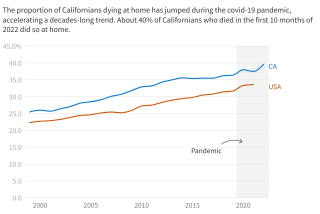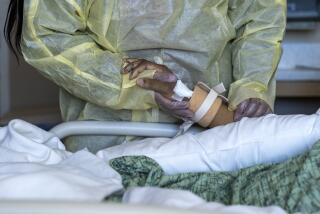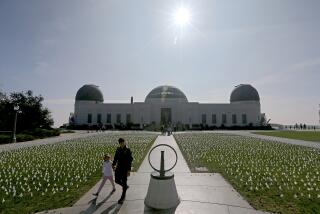Coronavirus grief is like no other. ‘Everything just feels fake’
- Share via
It’s been seven weeks since Karen Blanks’ brother-in-law died from COVID-19, but his death still doesn’t seem real to her.
She and her husband couldn’t visit Scott Blanks in the hospital. They couldn’t view his body at the mortuary before he was cremated. They’re not holding a memorial service until large gatherings are permitted.
“Everything just feels fake — like I’m in this big, clouded fog, and someone is telling me, ‘Your brother-in-law died,’ ” she said. “It doesn’t feel real because everything has been so different.”
The cruel toll of the COVID-19 pandemic reaches beyond its victims to hundreds of thousands of family members and friends who have been robbed of communal support and time-honored rituals to help them cope with the loss of loved ones.
Long after a vaccine has halted the spread of the novel coronavirus, many of the bereaved will struggle with feelings of guilt and prolonged grief over all that they couldn’t do and say in the final days and hours of a relative’s life.
Sweeping virus-related restrictions — on bedside visits, funerals, church gatherings, support-group meetings, air travel and even consoling hugs from caregivers — are affecting not just COVID-19 victims and their survivors but “the way everyone is dying right now and how everyone is grieving,” said Dale Larson, a professor of counseling psychology at Santa Clara University.
“You couldn’t design a more impactful set of conditions to disrupt the kind of things we like to see happening to support us in times of loss and grief. It’s just staggering,” he said. “I think the novel coronavirus is creating a novel form of traumatic bereavement for a large number of survivors.”
Karen Blanks had known Scott, a 34-year-old dental assistant from Whittier, since he was a freshman in high school and she started dating his older brother Quentin.
“He was my Scottie. I loved him,” she said. “Not being able to be by his side — for me, it’s almost traumatizing.… Even after he passed, I wanted to go to the mortuary to see him, thinking that would be OK, and I couldn’t even do that.”
The social distancing, shelter-in-place rules and limits on hospital visitation that are hallmarks of the global pandemic have deprived people of the most fundamental deathbed connections.
They can’t hold a loved one’s hand, sleep next to their hospital bed, comb their hair or shave them.
“All of these physical and mammalian kinds of signals and bonding that we share with any other species — all of that caregiving is stripped away,” said Robert Neimeyer, director of the Portland Institute for Loss and Transition.
Forgiveness can’t be granted or sought. Years of estrangement can’t end with a deathbed vigil. “We are left holding a bag of a lot of unfinished conversations,” he said.
Stacey Silva is haunted by a phone call with her father, Gary Young, a week before he died of complications from COVID-19 in mid-March in a hospital in Gilroy, Calif. Although she had been able to see him through a glass partition in the intensive care unit, the hospital had stopped visits.
“He called me about 4 o’clock in the morning, and he had an [oxygen mask]. It was already hard to talk to my dad and have a conversation because he would start coughing after a couple of words,” Silva said. “I believe he was calling to tell me that they were intubating him. I didn’t understand, and he got frustrated and he hung up.
“That’s the last conversation I had with my dad, and I have so much guilt that I couldn’t understand and that I couldn’t tell him that I loved him,” she said through tears. “I think about that every day.”
Friends and family are giving her emotional support, “but nothing helps,” Silva said. “Unless you’ve lost a loved one in this particular manner, you really have no idea how this feels.”
Limits on the size of public gatherings and air travel are restricting or eliminating ancient rituals of mourning that help the living. Funerals are small or unattended. Memorial services are being postponed to unknown dates in the future. Families are choosing cremation for relatives rather than burial with only a few people present.
Virtual ceremonies and gatherings can help fill that void, Neimeyer said, if the bereaved are actively involved and not just passive observers. They can share memories and stories on Zoom or arrange a time when people across the country ritually light candles.
“Almost anything we do,” he said, “that returns to us a sense of agency, where we can in some measure exercise choice or take action.”
The coronavirus has upended the world of palliative care teams — the nurses, doctors, social workers and chaplains whose job it is to support patients and families in times of serious illness and death.
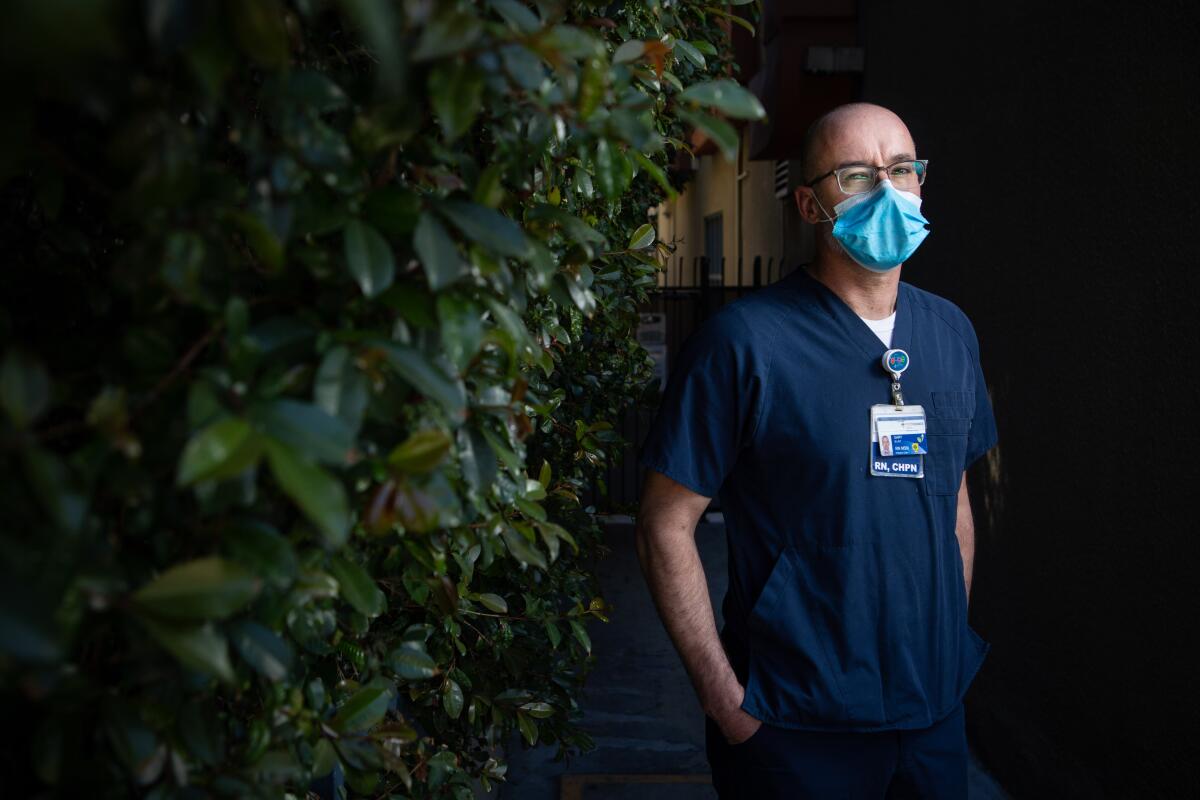
Gary Blunt is a palliative care coordinator at Providence Cedars-Sinai Tarzana Medical Center. As a palliative care nurse, he has been present at hundreds of deaths when he could hold a patient’s hand and comfort bereft family members.
But he has been “taken aback at times” by the end-of-life scenes wrought by the coronavirus.
The hospital converted a cardiac unit into a COVID-19 ward. Large, zippered sheets of heavy, opaque plastic seal the hallways and the open doors of each patient’s room. A small window of clear plastic provides a view of the bed.
No visitors are allowed in the rooms. To limit exposure, even the palliative staff avoids entering, meaning that the patient’s primary contact is with a bedside nurse cloaked in a gown, face shield, mask and gloves.
When death is near, the hospital will let one family member — wearing full protective gear — stand in the hallway and look through the window for a short period of time.
Late last month, Blunt’s team tried to prepare a woman for what she would experience if she came for a final glimpse of her dying husband.
He was confused and had been restrained so he couldn’t dislodge his oxygen mask and tubes. He would not be able to recognize her, garbed in gown and mask, peering through a small plastic window several feet from the bed. He would not be able to hear her against the hum of the room’s medical equipment.
In the end, she decided not to come. Instead, the family asked Blunt to play Neil Diamond songs on a Bluetooth speaker in the room and said goodbye on FaceTime.
A nurse held an iPad over the man’s face for about 15 minutes while his sobbing wife and son uttered their final endearments.
In normal times, medical staff would give a family privacy in such intimate moments. Witnessing it now can leave nurses with “this horrible guilt of being there, when you know you shouldn’t be there,” Blunt said. “It’s really tough.”
He worries about COVID’s lingering emotional impact on caregivers. “These will stick with us uniquely,” Blunt said. “I think a lot of staff are going to be scarred by this process and have a lot to work through.”
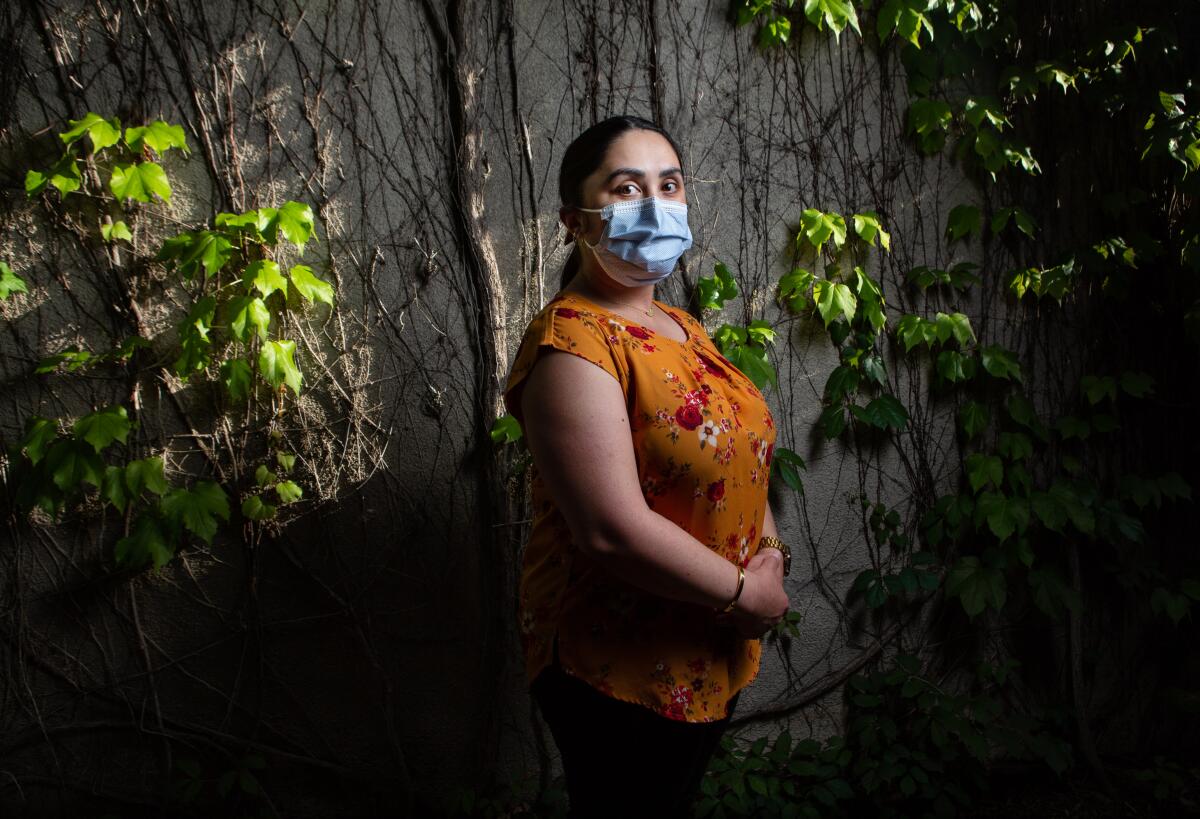
Rikki Larson is a clinical social worker at USC Verdugo Hills Hospital in Glendale, which allows short individual visits to patients on the verge of death.
But she can no longer console the grieving the way she always has. “I like to be able to hug people and comfort them,” she said. “I’ve left the hospital more times than I can tell with someone else’s tears on my shoulder.”
Now she has to keep her distance, at most quickly laying her hand on a shoulder. “It’s very hard — it’s not the same,” Larson said.
Stephanie Ryu, a chaplain on the palliative care team at Providence Little Co. of Mary Medical Center Torrance, is even more distant. She started working from home several weeks ago.
“None of us imagined in any universe we’d be able to do our jobs remotely,” she said. Given the severe limits on family visitation, she knows it’s not that different from the hospital, where she was already offering solace mostly on Zoom and FaceTime.
Only now, she said, “this grief is pouring out of my computer into my home.”
At hospitals that aren’t on the front lines of the COVID-19 battle, visitation limits aren’t as strict. But they can still be wrenching for families.
Rachel Rusch, a clinical social worker in palliative care at Children’s Hospital Los Angeles, will not soon forget her conversation with a teenage patient and her mother. The end was near for the girl, who had cardiovascular disease.
“The piece that has stayed in my heart,” Rusch said, “was the eyes of her mother across the bedside” as Rusch explained that, because of the COVID-19 pandemic, only a few members of their huge extended family would be allowed in the room during her daughter’s final hours.
Such experiences have left Rusch thinking of “all the ripple effects that are going to continue in the days and weeks and months and years to come because the end of someone’s story was so altered from anything anyone might have prepared themselves for,” she said.
Wayne Strom entered the Kensington assisted living facility in Redondo Beach in early December after a series of falls made it difficult for him to walk.
His wife, Kathy, who was staying with her mother in Rancho Palos Verdes, spent every day with him, helping with his physical therapy and eating meals together.
That routine came to an abrupt halt on March 12, when the pandemic prompted the Kensington to suspend family visits. Strom switched to calling Wayne several times a day and realized something was amiss in late March when he said he was too tired to talk.
He was admitted to the hospital on March 30, tested positive for the coronavirus and died three days later. Strom had not seen her husband of 38 years for three weeks.
“I think it’s taken me a while to realize that he’s gone because I wasn’t with him at the end, and we haven’t had a memorial,” she said.
She still puts her cell phone by her bed, expecting Wayne to call to say their nightly prayer together.
More to Read
Sign up for Essential California
The most important California stories and recommendations in your inbox every morning.
You may occasionally receive promotional content from the Los Angeles Times.

